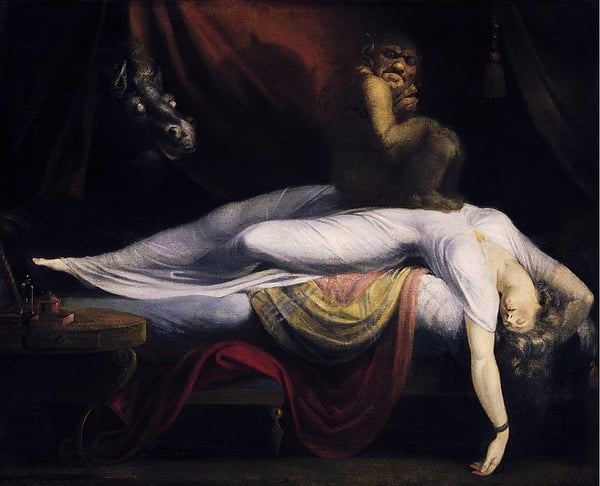What is Sleep Paralysis?
Sleep paralysis is an episode where you can’t move your body or speak directly after or directly before sleep, and while you are conscious. It is part of a collection of sleep disorders called parasomnias, which simply indicates that your sleep has some kind of general disruption. In the case of sleep paralysis, your body has trouble transitioning to and from sleep.
During an episode of sleep paralysis you will be:
- Unable to move
- Unable to speak
- Able to move your eyes
- Conscious
Sleep paralysis may be chronic, seldom, or only happen once. It can range from confusing to terrifying, and episodes can last a few seconds, or as long as a couple of minutes. Occasionally, though rare, they may last longer than two minutes.
Though sleep paralysis can be scary, it’s not dangerous.
What Causes Sleep Paralysis?
There doesn’t seem to be any central cause for sleep paralysis. That being said, sleep paralysis is more common in people who:
- Have narcolepsy
- Have a parent who experiences sleep paralysis
- Is taking certain medications, such as ADHD medications
- Experiences sudden changes in sleeping pattern, such as during travel or having a newborn baby
- Is suffering from sleep deprivation
- Has certain mental disorders
A lack of a clear cause, or having an underlying cause that is different for different people, can make treating sleep paralysis challenging or impossible.
What is it Like to Experience Sleep Paralysis?
An episode of sleep paralysis will make you feel totally helpless. This is mostly due to the fact that you can't move anything but your eyes, which can help you feel extremely helpless.
If you are used to it, it will probably be a little unsettling and maybe even frustrating. If you are not used to experiencing them, you will likely be scared or even terrified, especially if you are unaware that sleep paralysis is an actual disorder.
Historically, people thought that an episode of sleep paralysis was the result of being in the presence of a demon or evil spirit, as depicted in the photo below.

This picture is commonly thought to be a depiction of sleep paralysis
A typical first episode of sleep paralysis may be like this:
- You are in that restful but conscious state directly before sleep, or you have just opened your eyes after waking
- You try to roll over, grab your cell phone, or do anything, but you can’t move
- You feel suddenly scared
- You try to speak but you can’t move your mouth or make noise
- You desperately try to get the attention of your bed partner by moving your eyes back and forth frantically
- You try to move again but can’t, and now you feel terrified, perhaps breaking out in a cold sweat
If you are lucky, this will only last a few seconds (though it will probably feel like longer). However it can go on for a couple of minutes, and at some point you wonder things like:
- Did I have a stroke?
- Will I be paralyzed forever?
- Did something happen to my spinal cord?
- What if I can’t breathe?
Fortunately these episodes pass, but are very disconcerting. If you have experienced them before, the knowledge that you will be okay is enough to take some of the edge off of these episodes.
Ways to Avoid Sleep Paralysis
As said, there’s no treatment for sleep paralysis specifically. But there are some things you can do to help avoid it.
First of all, if you have an underlying cause, treat the underlying cause. For example, if you have narcolepsy, for which sleep paralysis is a common symptom, treating your narcolepsy may help prevent or eliminate these episodes.
If there is no underlying cause, some things you can do are:
- Get enough sleep – avoid becoming sleep deprived
- Avoid sleeping on your back, which is linked to sleep paralysis
- Talk with your doctor if you are experiencing these episodes in conjunction with serious mood problems
If sleep paralysis is a scary or chronic experience in your life, reach out to one of our sleep specialists who can help you get answers. Start by taking this free online sleep test:


